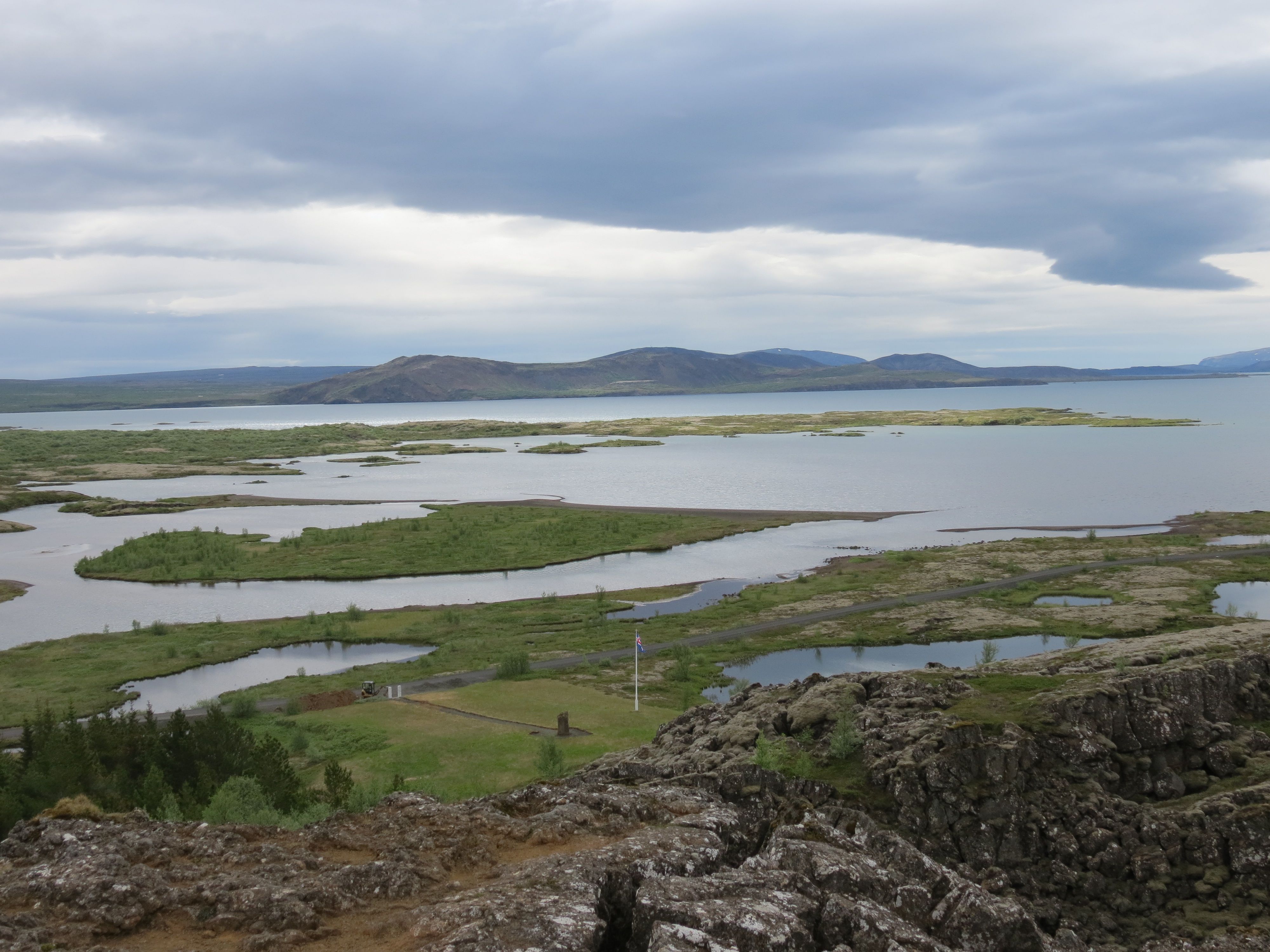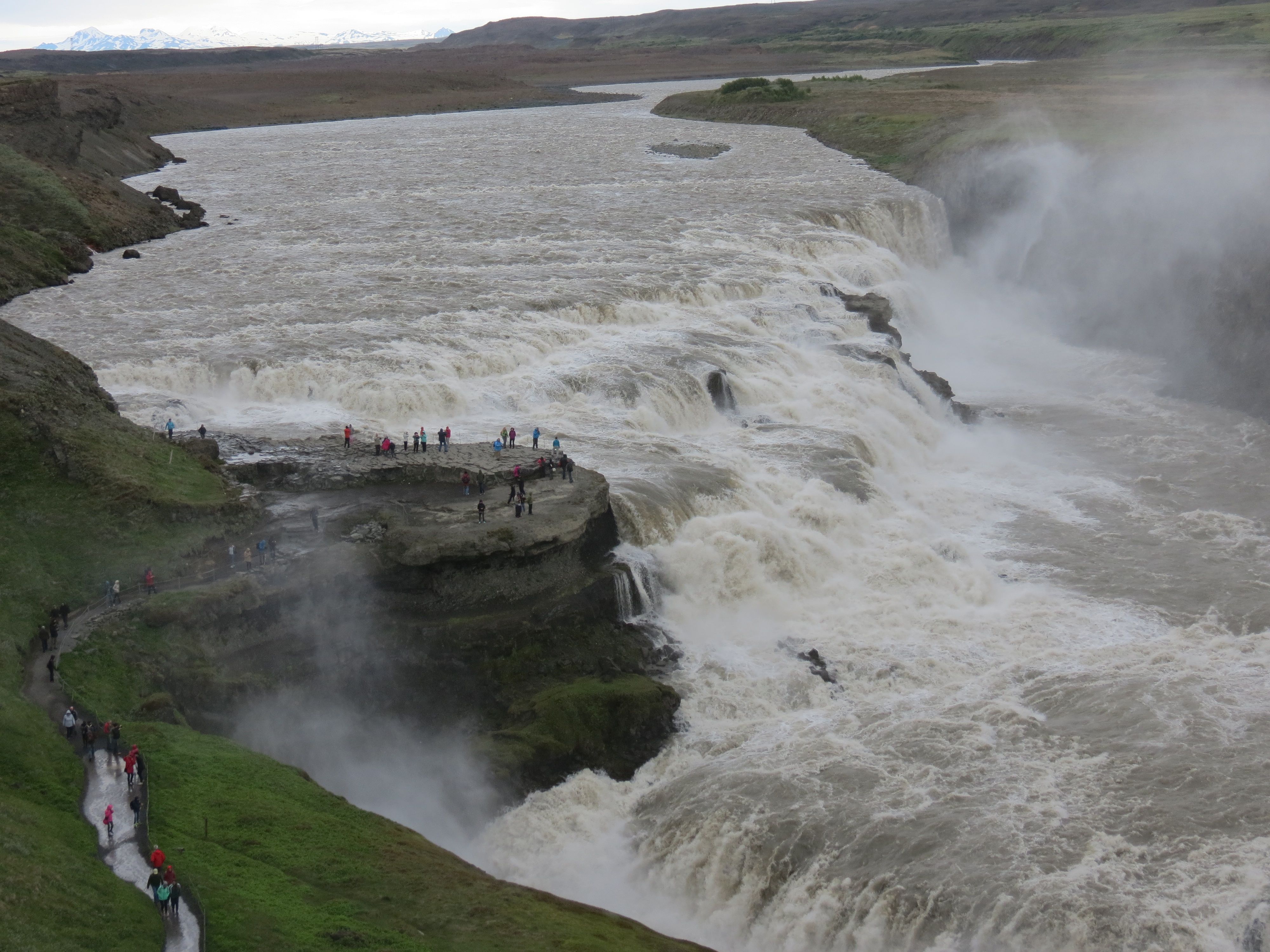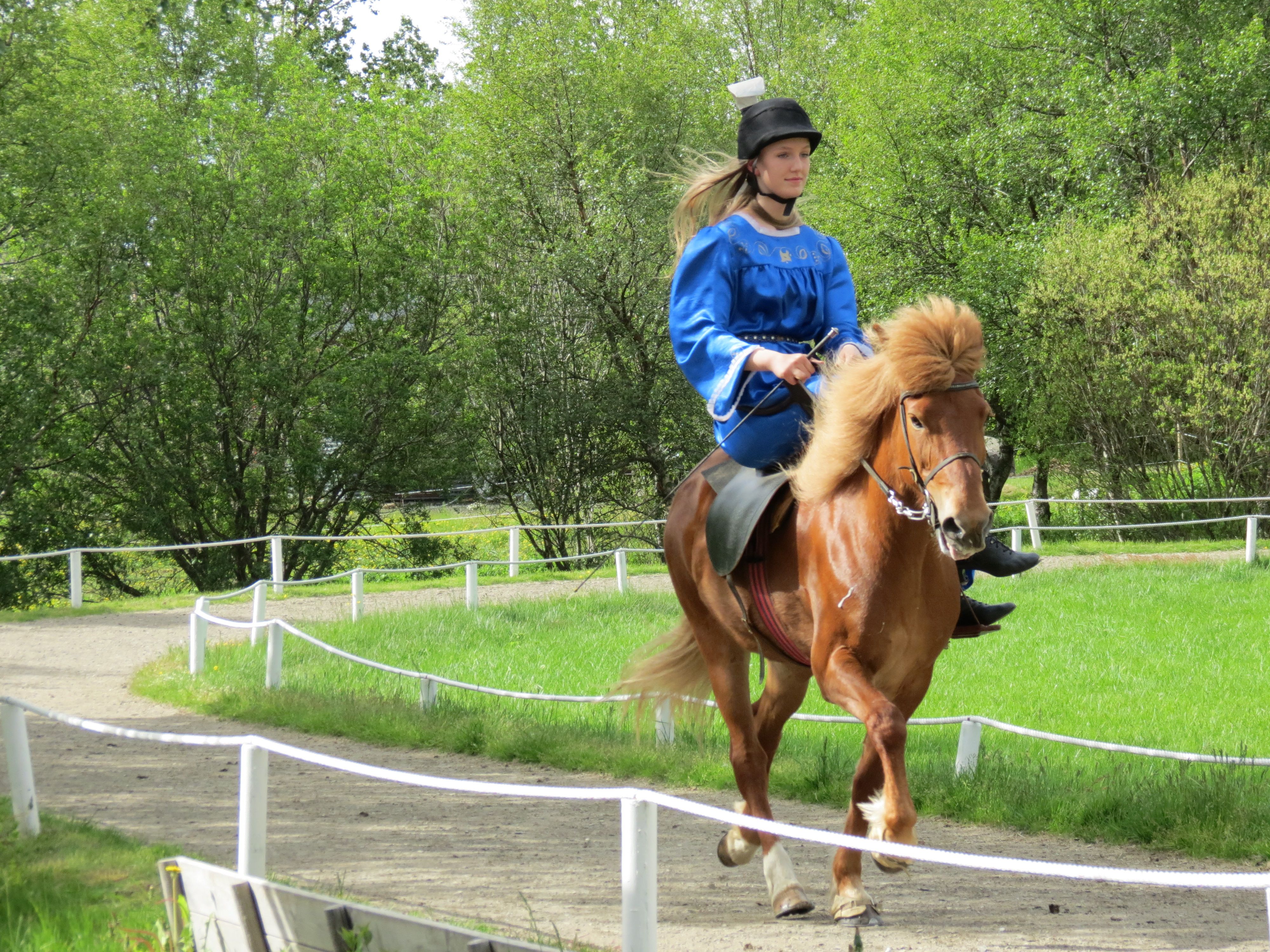
|
–Geoff-Hart.com: Editing, Writing, and Translation —Home —Services —Books —Articles —Resources —Fiction —Contact me —Français |
by Geoff Hart
Previous installment: June 28th whale watching and horse-ridingToday was a busy day, with four major stops and relocation to a new hotel in Hvolsvollur (pronounced something like “kyohlvodlur”, if memory serves). So: onwards!
Our first stop was the Thingvellir Rift Valley, relatively rich land that features a lake stocked with abundant fish, an important asset when you're hosting a gathering of the clans. Thus, this became the site of the Althing -- the first Icelandic parliament. This was initially a gathering of regional leaders to discuss matters of import for all Icelanders and administer both ruthless justice (e.g., murder of a malefactor by the victim's family) and ruthless injustice (e.g., burning of so-called sorcerors at the stake, mostly men as it happens), as well as simpler remedies such as fines and outlawry. The Althing has existed, in one form or another, for more than 1000 years; it was founded in 930 A.D., and continues today as the oldest parliament in the world, albeit in a different form from that of its origins. Among other things, there appear to be fewer beheadings as a result of its deliberations.
For the geologists and geologist wannabes among us, Thingvellir is a rift valley that straddles the mid-Atlantic ridge, where the North American plate is spreading apart from the Eurasian plate. This spreading has created a valley that appears to be at least a mile wide, spreading apart in the middle and widening the valley. Along the edges, there are deep stress cracks (fracture lines where the lava was pulled apart along faults) running roughly parallel to the plate boundaries. There’s a lovely mid-sized river that winds its way down one edge of the valley and runs into a large lake, Thingvallavatn, which is surrounded by volcanic mountains and ridges, some still covered in snow at higher altitudes. Quite lovely, and as the clouds waxed and waned, so did the light and colors. Here’s some typical lake scenery:

On the human interest side, a group of four Buddhist monks was visiting while we were there, clad in off-the-shoulder saffron robes despite the cold wind. They’d also come to enjoy the view... and, amusingly, to record it on their iPads and iPhones, including a couple times when they paused to do selfies. One of them was stone-faced serious throughout and seemed to be consulting his iPhone (possibly keeping up on business back at the monastery?), but the others seemed to be having a blast. One in particular had a positively radiant and contagious smile. I suspect he’s the one who gets in trouble with the head monk more frequently than is wise. Here’s him sharing a smile with his buddies:

Our next stop was the Gullfoss Waterfall, which is fed by meltwater from the nearby glacier. “Gull” is pronounced something like “ghoul-dle”, and means “golden” (due to the quality of the light on the water on a sunny day). Insert rant about linguists choosing nonsensical phonemes (in what terrestrial language does an English “L” character get pronounced like a “d” when you could instead just use a “d”?). They’re also responsible for Eyjafjallajokul (the volcano that shut down air traffic in much of Europe a few years back during its eruption) being pronounced something like “eye-ah-fyadla-yokoodla”. Guys: we have a “d” in our alphabet. Use it!
OK, end rant. Dick told us he considers this waterfall to be the most beautiful one in the world. There may be others more spectacular (e.g., Victoria Falls in Africa), but Gullfoss was certainly gorgeous. The normal flow rate is apparently on the order of 200 cubic metres (1000 cubic feet) per second, but after a flash flood, the flow has increased to as much as five times that much water, overflowing the gorge. Downwind of the gorge, there’s a continuous mist caused by water crashing against the walls and flying into the air, and there’s a fascinating “rain forest” of mosses and other low vegetation thriving where the mist falls. Here’s a shot of the top falls, with a drop of 30+ feet to the first ledge, followed by a second drop of more than 60 feet (11 and 20 m, to be precise):

Our next stop was at the “Geysir” site; geysir is the Icelandic word that gave us the English word geyser. The original Geysir stopped erupting a few years back, but the nearby Strokkur geyser continues to vent spectacularly. The geyser itself is a circular water-filled crater that looks to be about 30 feet across, with a smaller central core about 6 feet wide. Before an eruption, you see a few bubbles in the center, with the water level surging upwards and then back down by a few inches at a time, overflowing slightly to lap at an outer wetted area. This happens a handful of times, almost as if the geyser is teasing you. Then, immediately before an eruption, you see a beautiful aquamarine-colored column of water rise to the surface, bulge outwards like an inflating balloon, fill with white bubbles, and then explode upwards a good 50 feet. It’s like watching someone tentatively starting a bubblegum bubble, then going for the gusto: inflating it until the bubble bursts and gum recoils in all directions. After the plume of water dies down, a deep hole is exposed in the center of the crater, and the erupted water drains back into the hole (presumably along with groundwater), refilling the plumbing and building pressure for the next eruption. Most eruptions are a single spout, but there are also occasional double-eruptions within a space of a minute or so. Shoshanna was able to record a triple-eruption, which is very rare. My photos are tolerably good, but she has a video that can’t be surpassed:
One thing you quickly notice -- if you’re not a clueless tourist, that is -- is the wide area of dripping ground immediately downwind of the geyser. That and the steam blowing downwind through that area, occasionally obscuring the view, suggest that this is not the optimal place to stand. Yet before each eruption, at least one person nonetheless chooses to stand there. In their defence, it seems safe enough, since the area isn’t fenced off and there are no park rangers to warn you away, so it seemed inappropriate to say anything. (Also, possibly I’m just a cruel bastared who wanted to see someone get soaked. You be the judge.) As I watched, one poor woman and her friend chose precisely the wrong place to stand, and when the geyser went off with particular vigor, I could see her face fall as she realized what was about to happen: her head went back and back as the wall of water climbed above her like a tidal wave, then fell upon her, completely obscuring her from view. When the spray dissipated, she looked like someone had hit her with a firehose.
Funny though this was, things could have turned out worse. One of the women in our tour group said she’d talked to one of the rangers, and he told her that two kids had been burned so severely a week or two back that they had to be airlifted to the nearest hospital. As this is a third- or fourth-hand account, and nobody was being warned away from the downwind area during our visit, I infer that they were doing something beyond the usual tourist-stupid, like looking into the vent, when it erupted. The water emerges at just a few degrees below boiling, and cools rapidly as the pressure on it is released and it falls back to earth, but I suppose if you’re close enough it's still awfull warm... *shudder*
Our last stop of the day was a tour of one of Iceland’s ca. 100 geothermally warmed greenhouses. This particular place is one of Iceland’s 23 specialists in tomato production, and they produce on the order of 18% of all the tomatoes grown in Iceland. (That is, they supply the tomato needs of nearly 60 thousand Icelanders.) It’s a remarkably sophisticated operation. They use hot water from a nearby geothermal source to heat the greenhouse throughout the winter and to generate enough electricity to power its operations; the owner told us he consumed as much electricity as a community of 3000 people, largely to power the powerful sodium lights they use to accelerate growth, not to mention permit cultivation in the first place during the winter. They also obtain carbon dioxide from deep groundwater supplied by a nearby farmer, compress the hell out of it so they can store it in liquid form, and then use it to bump the carbon dioxide level in the greenhouse up to 900 ppm -- more than double the normal atmospheric concentration. The combination of warmth, high carbon dioxide, and intense light cranks the tomato plants up to their metabolic maximum; don’t quote me on the numbers (it’s the end of the day and I was tired), but I recall him saying that each tomato vine produces 22 kg of fruit before they give up the ghost and have to be replaced with the second crop of the year.
In addition to sophisticated computer controls to optimize all the environmental variables, they run a completely green operation: they import bumblebees from the Netherlands for pollination, use one species of parasitic wasp to control insect pests that invade the greenhouse during tomato cultivation, use another species of parasitic wasp to control insect pests during cucumber cultivation (which they do between tomato crops), and use carefully monitored and controlled fertilizer applications to ensure that the plants never run out of “food”. Forgot to ask him about diseases, but possibly the high light intensity sterilizes the leaf surfaces? Here’s a look at the greenhouse:

The same people also run an Icelandic horse stable. They told us that there are on the order of 100 thousand Icelandic horses, despite a population of only 300 thousand people. (This is way up from a low of about 7000 horses about 2 centuries ago, after a major volcanic eruption wiped out most of their population and a large portion of the Icelanders too.) The horses are purebreds, and haven’t had any inputs of genes from other types of horse for centuries, so Iceland now runs an elaborate breeding program, with pedigrees going back at least 80 years, to prevent inbreeding. Most of the horses are no longer used as working animals: many are essentially family pets or recreational riding animals, but some are used primarily for breeding more Icelandic horses, and a significant number are killed for their meat. I can’t imagine eating animals that I’ve formed a personal bond with, including horses and dogs, but since I do eat meat, I can’t claim any ethical high ground here. If I’d raised cattle or sheep, I probably couldn’t eat them either.
The owner’s daughter, “Caritas” (spelling?), and a couple neighbor’s daughters, gave us a riding demonstration. They were all excellent riders, and the horses were beautiful to watch. Caritas did a particularly good job, as her role was to ride side saddle in full-length gown. Amusingly, they demonstrated that you can indeed ride the horses during their “tölt” gait, holding a mostly full beer mug raised in a toast, without spilling a drop. (Though one did spill a bit on her third pass. Oh well! The point remains valid in principle.) Here’s Caritas in full flight:

We ended the day at a small but pleasant hotel in a town along the Ring Road, which runs around the full perimeter of Iceland. The Hotel Hvolsvollur (in the city of Hvolsvollur) will be our base for the next 3 days. It’s very much simpler than the Hotel Grand, and in terms of décor, much more in the Ikea line of furnishings. But it’s clean, quiet, and comfortable. Dinner was at Gallery Pizza, also not so much with the décor, but with really good pizza. We opted for one with a batch of familiar toppings (onions, sweet peppers, mushrooms, chicken, mozzarella), but also some less usual (pepper jack cheese) and some really unusual (banana slices). We’d originally thought to save some for lunch the following day, but instead devoured the whole thing. The bananas were weird, but somehow they worked.
Next installment: 30 June in the Westman Islands
©2004–2024 Geoffrey Hart. All rights reserved.